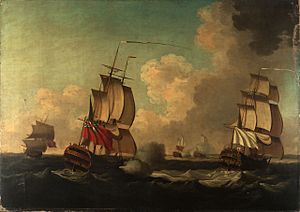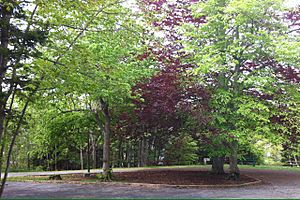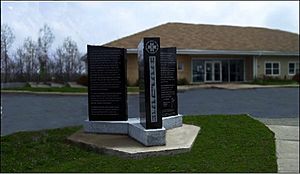Jean-Baptiste Cope facts for kids
Quick facts for kids
Jean-Baptiste Cope
|
|
|---|---|

Signature of Jean Baptiste Cope (Beaver)
|
|
| Nickname(s) | Major Cope |
| Born | 1698 Port Royal, Nova Scotia |
| Died | October, 1758-1760 Miramichi, New Brunswick |
| Battles/wars | Father Rale's War
|
Jean Baptiste Cope (whose Mi’kmaq name, Kopit, means ‘beaver’) was also known as Major Cope. This title was likely given to him by the French military, showing he held a high rank among the Mi’kmaq. Cope was a sakamaw (chief) of the Mi’kmaq people from Shubenacadie, Nova Scotia (also known as Indian Brook 14 in Mi’kma'ki).
Cope had strong connections with the Acadians living along the Bay of Fundy. He spoke French and was Catholic. During Father Le Loutre's War, Cope was involved in both fighting against the British and trying to make peace with them. He was in Miramichi, New Brunswick, during the French and Indian War, where he is thought to have died.
Cope is perhaps most famous for signing the Treaty of 1752 with the British. This treaty was confirmed by the Supreme Court of Canada in 1985. It is celebrated every year on Treaty Day (October 1) along with other important treaties.
Contents
Cope's Early Life and First War
Jean Baptiste Cope was born in Port Royal, Nova Scotia, and was the oldest of six children. When he was about 28 years old, during a conflict called Father Rale's War, Cope likely signed the peace treaty that ended the fighting between the New Englanders and the Mi’kmaq.
Leading During King George’s War
During King George's War, Cope became an important leader in the Shubenacadie area. This region was home to many Mi’kmaq families and some Acadian farms. The main Mi’kmaq village, Copequoy, became a Catholic mission in 1722. This village was a significant gathering place for Mi’kmaq from far away, especially for annual events.
In 1737, a Catholic missionary named Le Loutre took over the Shubenacadie mission. During King George’s War, Cope and Le Loutre worked together. They led several actions against the British forces.
Father Le Loutre’s War and Peace Efforts
When Father Le Loutre's War began, the missionary Le Loutre encouraged Mi’kmaq and Acadian refugees to move to French-controlled land. Many Mi’kmaq from Shubenacadie followed him. However, Cope and at least ninety other Mi’kmaq chose to stay in their homes.
Cope might not have supported the French at first. But he changed his mind after Edward Cornwallis established Halifax. The Mi'kmaq believed that creating Halifax broke earlier treaties signed in 1726. Cope tried to arrange peace treaties, but he was not successful.
Cornwallis offered money for the scalps of Mi’kmaq families. The French had also offered money for the scalps of British colonial families. Over time, leaders on both sides started to see the conflict as a "race war." They believed each side wanted to drive the other out of Nova Scotia.
After Halifax was built, Cope seemed to join Le Loutre. From this area, Cope and other Mi’kmaq war leaders launched raids. These attacks kept the new British settlers close to Halifax. British plans to spread Protestants across Nova Scotia were put on hold.
The Battle at Chignecto
After the Battle at Chignecto on September 3, 1750, Le Loutre and the French forces pulled back. The British began building Fort Lawrence. About a month later, on October 15, Cope approached the British. He was disguised in a French officer's uniform and carried a white flag of truce. During this meeting, Captain Edward Howe was killed. Years later, Cope claimed he was the one who killed the British officer.
The Peace Treaty of 1752
After a year and a half of fighting, both the Mi’kmaq and the British wanted peace. By the summer of 1751, Governor Cornwallis started to try a more peaceful approach. He looked for Mi’kmaq leaders who would talk about peace. Eventually, he gave up and left the colony.
A new Governor, Peregrine Hopson, took over. Cope was the first and only Mi’kmaq negotiator to come forward. On November 22, 1752, Cope finished negotiating a peace treaty for the Mi’kmaq at Shubenacadie. This treaty was based on the one signed in Boston that ended Father Rale's War in 1725.
Cope tried to get other Mi’kmaq chiefs in Nova Scotia to agree to the treaty, but he couldn't. The Governor became unsure how much power Cope truly had among the Mi’kmaq. Of course, Le Loutre and the French were very angry that Cope had negotiated with the British at all.
Attack at Jeddore
In response to an earlier attack, on April 21, 1753, Major Cope led Mi'kmaq warriors to attack a British group. This group included Captain Bannerman and his crew near Jeddore, Nova Scotia. They were on a schooner with nine British passengers and a pilot named Anthony Casteel. The Mi'kmaq killed the British passengers. They let Casteel go at Port Toulouse and then sank the schooner after taking its goods.
As the war continued, on May 23, 1753, Cope burned the peace treaty of 1752. The treaty he signed with Governor Hobson had lasted less than six months. Soon after, Cope rejoined Le Loutre. He worked to convince Acadians to join the movement away from Nova Scotia.
After their experience with Cope, the British were less likely to trust Mi’kmaq peace efforts. Future peace treaties also failed. This was because Mi’kmaq proposals always included land claims. The British saw this as giving land to the French.

In a naval battle on June 8, 1755, off Cape Race, Newfoundland, French ships were captured. On board the ships Alcide and Lys, British forces found 10,000 scalping knives. These were meant for Acadians and Mi'kmaq fighting under Chief Cope and Acadian Beausoleil.
French and Indian War and Cope's Death
During the French and Indian War, Governor Lawrence again offered money for the scalps of Mi’kmaq men. Cope was likely among the Mi’kmaq and their allies who helped Acadians avoid capture. This happened during the St. John River campaign.
Records from Louisbourg show that from 1756 to 1758, the French regularly paid Cope and other Indigenous people for British scalps. Cope is believed to have gone to Miramichi, New Brunswick. This was an area where French Officer Boishebert had a refugee camp for Acadians escaping deportation. Cope likely died in that region before 1760.
The Battle at St. Aspinquid's Chapel

According to tradition, during the French and Indian War, Lahave Chief Paul Laurent and eleven others invited Shubenacadie Chief Jean-Baptiste Cope and five others to St. Aspinquid's Chapel (in Point Pleasant Park) to discuss peace with the British. Chief Paul Laurent had just surrendered to the British.
In early March 1760, the two groups met. They ended up fighting. Chief Laurent's group killed Cope and two others. Chief Cope’s group killed five of the British supporters. Soon after Cope's death, Mi'kmaq chiefs signed a peace treaty in Halifax on March 10, 1760. Chief Laurent signed for the Lahave tribe, and a new chief, Claude Rene, signed for the Shubenacadie tribe.
Cope's Legacy
After the treaty of 1752, even though conflict continued, the British never went back to trying to drive the Mi’kmaq off the land. The treaty signed by Cope and Governor Hobson was upheld by the Supreme Court in 1985.
Today, there is a monument to the Peace Treaty on the Shubenacadie Reserve (Indian Brook 14, Nova Scotia). Cope's descendants gave his gun to the museum at Citadel Hill (Fort George).
The author Thomas Raddall wrote about Cope in his novel Roger Sudden.
See also


